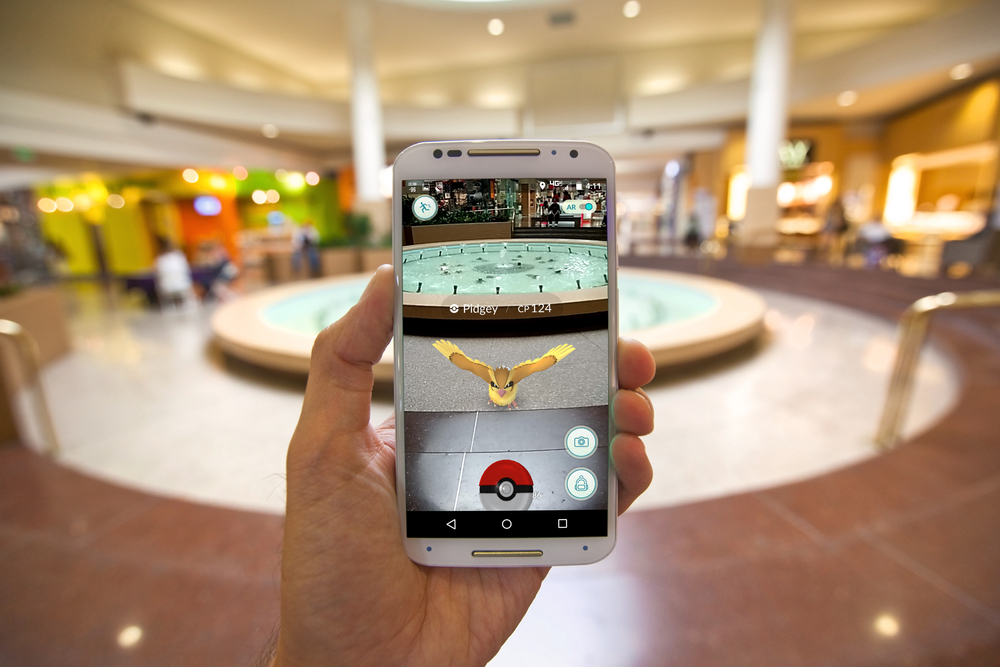 Coming into 2016, virtual reality had the buzz. Facebook announced that it would (finally!) release its high-end Oculus Rift headset in the first quarter of the year. Not to be outdone, HTC and Valve rolled out the HTC Vive in April. Meanwhile, Google teased its own VR platform targeted at the mid-range market. But even as consumers and businesses tentatively embraced VR content, a funny thing happened: augmented reality (AR) began to show signs of becoming an aggressive competitor for eyeballs and wallets. First came “Pokémon Go,” the augmented-reality game for mobile devices. Released by Nintendo in conjunction with Niantic Labs and The Pokémon Company, “Pokémon Go” leveraged smartphone cameras to overlay digital holograms of fantastic creatures over the user’s real-world environment. Despite an inevitable drop-off in downloads in the months following its release, the game still raked in millions of dollars for its creators. As “Pokémon Go” became a summertime blockbuster, Apple CEO Tim Cook announced on his company’s earnings call that “we are high on AR for the long run.” The technology offers “a great commercial opportunity,” he added, and Apple had already invested a considerable amount of money in research and development: “The number one thing is to make sure our products work well with other developers’ kind of products like ‘Pokémon.’” Cook’s phrasing suggests that Apple is hard at work on some sort of hardware to power augmented-reality experiences, whether an independent headset or some sort of augmentation (pun intended) to its existing devices. Even as Apple hinted at its augmented reality intentions, Microsoft inched closer to releasing the HoloLens, an augmented-reality headset with an onboard processor. In August, the company made the hardware available to developers for the low, low price of $3,000. And other companies are using millions in venture funding to explore the space, including Magic Leap, a Florida-based startup that has racked up more than $1.4 billion in capital from Google, Andreessen Horowitz, and other major players. Although VR isn’t struggling for mind-share, it didn’t spark the consumer rush that some expected this year—possibly because of the high costs of headsets and other hardware. But don’t count out VR just yet. “I think the only [wrong] thing some pundits were predicting was that in the first year VR would sell many millions of units, and of course that didn’t happen,” Epic co-founder Tim Sweeney, a big advocate of VR, recently told The Verge. “And that causes some people to say, ‘Oh, VR has failed, it’s not going anywhere.’ But I think what really matters with VR isn’t the smallness of the starting point, but the exponent it grows by every year.” Meanwhile, between dedicated headsets and smartphone apps, augmented reality enters 2017 in a very strong position. If you’re a developer interested in the technology, now’s a good time to do some exploring.
Coming into 2016, virtual reality had the buzz. Facebook announced that it would (finally!) release its high-end Oculus Rift headset in the first quarter of the year. Not to be outdone, HTC and Valve rolled out the HTC Vive in April. Meanwhile, Google teased its own VR platform targeted at the mid-range market. But even as consumers and businesses tentatively embraced VR content, a funny thing happened: augmented reality (AR) began to show signs of becoming an aggressive competitor for eyeballs and wallets. First came “Pokémon Go,” the augmented-reality game for mobile devices. Released by Nintendo in conjunction with Niantic Labs and The Pokémon Company, “Pokémon Go” leveraged smartphone cameras to overlay digital holograms of fantastic creatures over the user’s real-world environment. Despite an inevitable drop-off in downloads in the months following its release, the game still raked in millions of dollars for its creators. As “Pokémon Go” became a summertime blockbuster, Apple CEO Tim Cook announced on his company’s earnings call that “we are high on AR for the long run.” The technology offers “a great commercial opportunity,” he added, and Apple had already invested a considerable amount of money in research and development: “The number one thing is to make sure our products work well with other developers’ kind of products like ‘Pokémon.’” Cook’s phrasing suggests that Apple is hard at work on some sort of hardware to power augmented-reality experiences, whether an independent headset or some sort of augmentation (pun intended) to its existing devices. Even as Apple hinted at its augmented reality intentions, Microsoft inched closer to releasing the HoloLens, an augmented-reality headset with an onboard processor. In August, the company made the hardware available to developers for the low, low price of $3,000. And other companies are using millions in venture funding to explore the space, including Magic Leap, a Florida-based startup that has racked up more than $1.4 billion in capital from Google, Andreessen Horowitz, and other major players. Although VR isn’t struggling for mind-share, it didn’t spark the consumer rush that some expected this year—possibly because of the high costs of headsets and other hardware. But don’t count out VR just yet. “I think the only [wrong] thing some pundits were predicting was that in the first year VR would sell many millions of units, and of course that didn’t happen,” Epic co-founder Tim Sweeney, a big advocate of VR, recently told The Verge. “And that causes some people to say, ‘Oh, VR has failed, it’s not going anywhere.’ But I think what really matters with VR isn’t the smallness of the starting point, but the exponent it grows by every year.” Meanwhile, between dedicated headsets and smartphone apps, augmented reality enters 2017 in a very strong position. If you’re a developer interested in the technology, now’s a good time to do some exploring. Could 2017 Prove Augmented Reality's Breakout Year?
 Coming into 2016, virtual reality had the buzz. Facebook announced that it would (finally!) release its high-end Oculus Rift headset in the first quarter of the year. Not to be outdone, HTC and Valve rolled out the HTC Vive in April. Meanwhile, Google teased its own VR platform targeted at the mid-range market. But even as consumers and businesses tentatively embraced VR content, a funny thing happened: augmented reality (AR) began to show signs of becoming an aggressive competitor for eyeballs and wallets. First came “Pokémon Go,” the augmented-reality game for mobile devices. Released by Nintendo in conjunction with Niantic Labs and The Pokémon Company, “Pokémon Go” leveraged smartphone cameras to overlay digital holograms of fantastic creatures over the user’s real-world environment. Despite an inevitable drop-off in downloads in the months following its release, the game still raked in millions of dollars for its creators. As “Pokémon Go” became a summertime blockbuster, Apple CEO Tim Cook announced on his company’s earnings call that “we are high on AR for the long run.” The technology offers “a great commercial opportunity,” he added, and Apple had already invested a considerable amount of money in research and development: “The number one thing is to make sure our products work well with other developers’ kind of products like ‘Pokémon.’” Cook’s phrasing suggests that Apple is hard at work on some sort of hardware to power augmented-reality experiences, whether an independent headset or some sort of augmentation (pun intended) to its existing devices. Even as Apple hinted at its augmented reality intentions, Microsoft inched closer to releasing the HoloLens, an augmented-reality headset with an onboard processor. In August, the company made the hardware available to developers for the low, low price of $3,000. And other companies are using millions in venture funding to explore the space, including Magic Leap, a Florida-based startup that has racked up more than $1.4 billion in capital from Google, Andreessen Horowitz, and other major players. Although VR isn’t struggling for mind-share, it didn’t spark the consumer rush that some expected this year—possibly because of the high costs of headsets and other hardware. But don’t count out VR just yet. “I think the only [wrong] thing some pundits were predicting was that in the first year VR would sell many millions of units, and of course that didn’t happen,” Epic co-founder Tim Sweeney, a big advocate of VR, recently told The Verge. “And that causes some people to say, ‘Oh, VR has failed, it’s not going anywhere.’ But I think what really matters with VR isn’t the smallness of the starting point, but the exponent it grows by every year.” Meanwhile, between dedicated headsets and smartphone apps, augmented reality enters 2017 in a very strong position. If you’re a developer interested in the technology, now’s a good time to do some exploring.
Coming into 2016, virtual reality had the buzz. Facebook announced that it would (finally!) release its high-end Oculus Rift headset in the first quarter of the year. Not to be outdone, HTC and Valve rolled out the HTC Vive in April. Meanwhile, Google teased its own VR platform targeted at the mid-range market. But even as consumers and businesses tentatively embraced VR content, a funny thing happened: augmented reality (AR) began to show signs of becoming an aggressive competitor for eyeballs and wallets. First came “Pokémon Go,” the augmented-reality game for mobile devices. Released by Nintendo in conjunction with Niantic Labs and The Pokémon Company, “Pokémon Go” leveraged smartphone cameras to overlay digital holograms of fantastic creatures over the user’s real-world environment. Despite an inevitable drop-off in downloads in the months following its release, the game still raked in millions of dollars for its creators. As “Pokémon Go” became a summertime blockbuster, Apple CEO Tim Cook announced on his company’s earnings call that “we are high on AR for the long run.” The technology offers “a great commercial opportunity,” he added, and Apple had already invested a considerable amount of money in research and development: “The number one thing is to make sure our products work well with other developers’ kind of products like ‘Pokémon.’” Cook’s phrasing suggests that Apple is hard at work on some sort of hardware to power augmented-reality experiences, whether an independent headset or some sort of augmentation (pun intended) to its existing devices. Even as Apple hinted at its augmented reality intentions, Microsoft inched closer to releasing the HoloLens, an augmented-reality headset with an onboard processor. In August, the company made the hardware available to developers for the low, low price of $3,000. And other companies are using millions in venture funding to explore the space, including Magic Leap, a Florida-based startup that has racked up more than $1.4 billion in capital from Google, Andreessen Horowitz, and other major players. Although VR isn’t struggling for mind-share, it didn’t spark the consumer rush that some expected this year—possibly because of the high costs of headsets and other hardware. But don’t count out VR just yet. “I think the only [wrong] thing some pundits were predicting was that in the first year VR would sell many millions of units, and of course that didn’t happen,” Epic co-founder Tim Sweeney, a big advocate of VR, recently told The Verge. “And that causes some people to say, ‘Oh, VR has failed, it’s not going anywhere.’ But I think what really matters with VR isn’t the smallness of the starting point, but the exponent it grows by every year.” Meanwhile, between dedicated headsets and smartphone apps, augmented reality enters 2017 in a very strong position. If you’re a developer interested in the technology, now’s a good time to do some exploring. 


